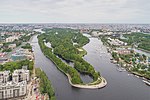Datsan Gunzechoinei
20th-century Buddhist templesBuddhism in RussiaCultural heritage monuments of federal significance in Saint PetersburgReligious buildings and structures completed in 1915Religious buildings and structures in Saint Petersburg ... and 1 more
Tibetan Buddhism in Europe

The Datsan Gunzechoinei is a large Buddhist temple in Saint Petersburg, Russia. It is the northernmost Buddhist temple in Russia.
Excerpt from the Wikipedia article Datsan Gunzechoinei (License: CC BY-SA 3.0, Authors, Images).Datsan Gunzechoinei
Приморский проспект, Saint Petersburg Novaya Derevnya (округ № 65)
Geographical coordinates (GPS) Address Nearby Places Show on map
Geographical coordinates (GPS)
| Latitude | Longitude |
|---|---|
| N 59.9836 ° | E 30.2558 ° |
Address
Храм Дацан Гунзэчойнэй
Приморский проспект
197183 Saint Petersburg, Novaya Derevnya (округ № 65)
Saint Petersburg, Russia
Open on Google Maps









